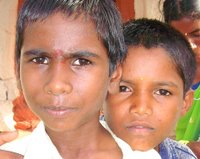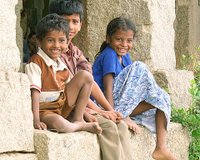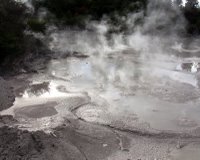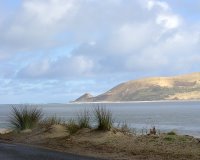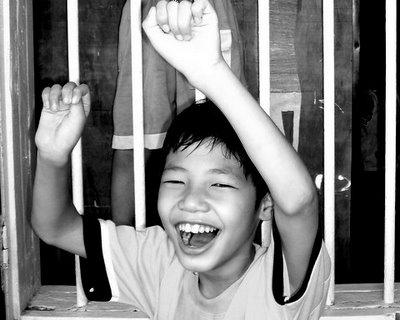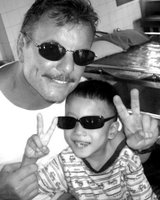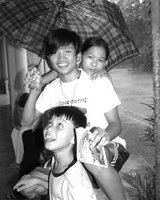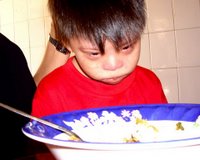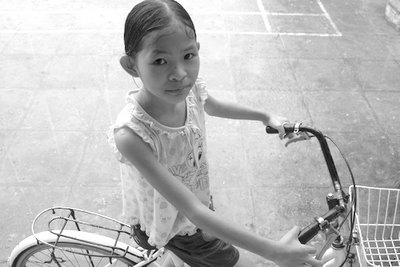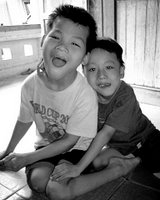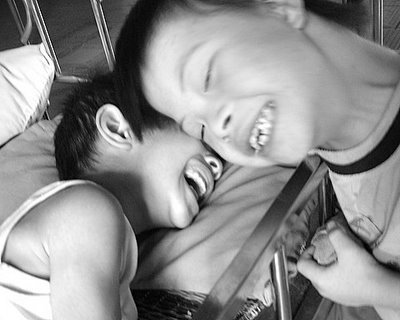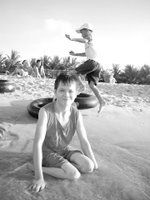 Damaged seeds, in a tainted garden
Damaged seeds, in a tainted garden
“Those who can not remember the past are condemned to repeat it.”
A seven year old girl lies on her back above a bamboo mat, atop a steel grate bed. Her dark eyes follow every movement in the crowded room. The quickened flutter of her long eyelashes is the only communication she has with the world. If she could even hold the weight of her own head, she might lift it off the dirty pillow, turn to me and ask, ‘Why am I like this?’ But she can’t. She’s trapped in a paralyzed body and can’t even speak. But I can and wonder, why is she like this?
HongNhi is one of the many children in Vietnam born with hydrocephalus, only she was not given the operation that allows a shunt to drain fluid from her brain. She is no longer considered a candidate for surgery and there is no hope she will grow up like other children. It’s unlikely HongNhi will even survive. Day after day she just lies there, unable to move or make a sound. She is living her shortened life verdict, in a prison without parole. As I pick up her 35lbs. body with ease, carefully supporting her head from falling, her eyes make contact and lock with mine. Her lashes flutter and she gives me a Mona Lisa smile that is reminiscent of another time.
I flash back 31 years ago, holding a young Vietnamese girl on the narrow strip of a ship gangway. I haven’t slept since I arrived on the pacific island of Guam. It’s four days after my 20th Birthday on which my Navy SeaBee detachment, unexpectedly was mounted out of Japan to assist with the sudden evacuation of Saigon. The north Vietnamese army is advancing on the south to take control of the city and more than 60 thousand people are fleeing the county. They’re boarding planes and ships faster than we can unload them, leaving everything they own behind, trying to escape the Vietcong Army. Today I am unloading children off a boat and ushering them into a crowded tent city of pandemonium. These little ones have just made the four day passage in the hull of a giant ship, and I’m trying to bring comfort to the end of their emotional journey. Loud speakers roar out in a language they don’t understand, and their eyes are huge with fear of the unknown. Looking down at this little girl in my arms, I see her face filled with fright and I realize all I have to offer is a smile. When she looked up at me, she gave a small, almost forced Mona Lisa smile and then relaxed in the safety of my arms. I thought to myself, ‘What a terrible thing war does to innocent children, who are born in the wrong place at the wrong time.’
…And thirty one years later, still seem to be...
The Orphanage
Brenda and I passed through the ancient coastal town of Hoi An, five years ago. We were charmed with its quaint French flair situated over a lazy river leading to the bay of Tonkin in central Vietnam. On this visit we spent several days at the local government run orphanage and vowed to return to the children and town that we loved so much. Now that we have the time to give, we put Hoi An at the top of our itinerary and first stop on our personal crusade for humanity.
Our mission in this orphanage, is to help the staff serving the needs of 64 children, almost half of which suffer from disabilities. Hoi An is a small town, yet the orphanage is filled to capacity. In addition to the regular orphans there are 26 disabled children needing extensive care. A few days into assessing the routines of the orphanage, we committed ourselves to this group of handicapped children who’s needs were the most demanding. Their conditions vary from cerebral palsy, epilepsy, hydrocephalus, spinal bifida, down’s syndrome, paralysis, mental slowing, and severe deformity. Many can not walk or sit on their own. A good part of our day is spent, spoon feeding children that can’t even swallow normally. Properly feeding one child can take up to an hour. The remainder of our day consists in exercising their immobile joints, and simply moving them off their steel grate beds, into the comfort of loving arms. We swing and sing, talk and rock their stiff shrunken bodies. It’s the most rewarding time of our day.
The Education
After spending every day with the children we learn and enjoy each one of their unique personalities. Wanting to make our time with them more effective, we set out to learn about each child and their disability. Brenda acquires books dealing with Cerebral Palsy, and I look at helpless little HongNhi and decide to try my luck at the internet, starting with hydrocephalus. The www brings me to thousands of websites and a wealth of information. Skimming the sites, an opening statement catches my eye. There are references to US Vietnam veterans whose offspring suffer from hydrocephalus. I’m intrigued to find out more. Linking to another site, I find that the Red Cross has done a study showing 150 Thousand Vietnamese children with birth defects like hydrocephalus from parents who were exposed to a chemical called TCDD (Dioxin) during the Vietnam war. Could chemical poisoning have caused HongNhi’s condition? I follow the corresponding link showing TCDD Dioxin poisoning being a cause of not just hydrocephalus, but of the multiple birth defects we see in the children from the orphanage.
The Questions
It made me think. Is it possible that children born two generations from the Vietnam war could be effected by this Dioxin? Could it have passed through genes, and how did they come in contact with this poison? I return the following day to our group of 26 disabled children and reach in my pocket for the list of TCDD related defects and scan the room for confirmation. Almost every child’s primary or secondary disability is listed on the piece of paper. Is there a viable connection? I look around a room full of children suffering from birth defects, seeing enlarged heads, curved spines, and twisted bodies. My eyes stop at several pair of tiny deformed hands and feet, and as I gaze down on my crippled toes, I recall my own misfortune. I was diagnosed at an unusual early age of 26 with rheumatoid-psoriatic arthritis just six years after serving during the Vietnam war. After changing my lifestyle to accommodate severe chronic pain, treatments of chemo drugs and steroids to curb a skin condition, I found no relief. I was faced with the decision to remove the joints and bones from my receding toes. The disorder had advanced to a critical state and I had to choose to walk on crippled feet, or not walk at all.
I flash back to 1975 on active duty at a naval air base in Japan. In a dark empty warehouse on the Atsugi airfield, I crawl on my hands and knees rebuilding small machines in this make-shift shop. The place is huge but vacant besides myself, one other mate and a few machines that need fixing. I look over to my coworker and ask, ‘What is this warehouse supposed to be used for?’ I shrug off his explanation that this warehouse was stocked full, storing steel drums painted black with orange stripes. They contained the defoliant known as agent orange. It was loaded from here onto planes and used around the war zones in Vietnam. Most military installations, forests, and mangroves in the DMZ, south and central Vietnam were sprayed with the chemical to kill all foliage that could hide approaching enemy movement. From 1962 to 1971 the military destroyed 14% of the south Vietnamese forest in a mission called ‘Operation Ranch Hand.’ I continue to lye on the warehouse floor and scoot underneath the next engine completely uninterested.
The Findings
In my recollection following these days, I remember hearing of TCDD (Dioxin) being a compound found in agent orange. The Dioxin was claimed to cause health problems like cancer, liver/blood and skin diseases in US Vietnam veterans, some leading to death. Now in my quest for answers, I discovered that Hoi An had several US military bases in and around the town. My new acquired Vietnamese friend, who lived here during the war, took me out to the sites. Showing me three of the US military compounds that remain, he told me the surrounding area was originally covered in jungle but that the forest was cleared with a chemical. With little concern, he remembered it to be the chemical we call agent orange. I looked around the sites and observed in one direction, desert like soil, and miles of grave sites. Then turning the other direction, I saw a prosperous community that has sprung up on the once vacant land. This growing popular tourist destination has increased the towns population and people have built their homes and gardens on the same property once doused in agent orange. Peddling my bike back into town, I stop at the internet with more questions. The www tells me that the deadly poison TCDD found in agent orange does not dissipate in soil, and has to be physically removed from the site. I was literally stunned as I continued to unravel more findings. Dr Schector, a leading expert on dioxide contamination did a soil sample from a former US military base at BeinHoa Vietnam, where agent orange was stored. He found the TCDD levels were 180 MILLION times the safe levels set by the US environmental protection agency. Still completely shocked, I kept repeating to myself, ‘one hundred and eighty MILLION times. The soil sample was one hundred and eighty MILLION times above safe levels. How is this acceptable? I race back to find Brenda at our favorite corner lunch stall. She’s chomping on a leafy green salad and I instantly become ill thinking of all the people who had, have been and are continuing to eat plants and animals cultivated on this contaminated land. Has the food chain carried these toxins through generations of plants and animals into humans and…the side effects? I search again for the answers, finding that years of monsoon rains can help dilute the toxins but tests in 2003 found 6 of 16 food samples from the BeinHoa airbase had the same levels of Dioxin as those found during the Vietnam war. The study showed contaminated ducks, chicken, frogs and bottom fish, all which are ground dwelling animals. Thirty years of monsoon rains can help wash away poison from the earth, but can they cleanse the body?
The Responsibility?
Disturbed with my findings, I sadly approach the children at the orphanage with a weighed sense of responsibility. It was the leaders of my country that chose to blanket this area with 20 million gallons of a deadly chemical that is likely the source of their despair. Now for my own closure, I have to know what has been done to resolve this mistake, and how much did they know about this poison before literally covering a country with it? I was pleased to read on, that as relations were neutralizing between Vietnam and the US, in 2002 our government committed to a study in cooperation with the Vietnamese government. The aim was to measure the effects of agent orange in the Vietnamese people. The National Institute of Environmental Health Sciences (NIEHS) headed by Dr. Ann Sassaman came to Vietnam to take blood samples from the citizens who could be effected by agent orange poisoning. The NIEHS also wanted to remove lab samples of soil, flora and fauna to be studied further in the US. The Vietnamese government denied the request for the US to remove samples from Vietnam. In response to the denied request, in January 2005, Dr. Saussaman pulled the plug on the entire study stating, “The US will never do any kind of research on agent orange in Vietnam again.” Subsequently, our government broke their agreement with Vietnam stating they were, “Failing to receive necessary cooperation from the Vietnamese government.” End of study! No official findings made, no responsibility taken! The US just walked out on the study and retreated back to Washington. My initial response is, don’t we at least owe these people scientific answers? Don’t we owe more to their children, and their future generations? I now look around our room at the Hoi An orphanage, seeing recent victims of a war that ended thirty years ago.
Being the logical guy I am, I understand why the US government would be happy to take a back door out of the study. Ending the program meant they didn’t have the statistics needed to take responsibility for the use of agent orange in Vietnam. But why was the Vietnamese government reluctant to have the evidence removed and out of their control? Were they afraid the US government would make different findings once on US soil? Were they afraid the US would uncover something else? Were they afraid of publicity? Is the Vietnamese government keeping information from its citizens? I’ve spoke to several Vietnamese veterans about the use of agent orange, and they’re all completely unaware of the side effects. Perhaps the government doesn’t want the world to know of the elevated toxins found on its soil? This rapid growing country economically relies on tourism and the export of its goods and foods all over the world. Would a government sacrifice its people for economic reasons?
Concluding my research, I looked for early testing done on TCDD. I found the chemical gaining the most publicity in the 60‘s. Scientists from all over the states were calling for a halt to Operation Ranch Hand, calling it “barbarous.” Varied organizations joined forces with the scientists in 1969 when they discovered agent orange to cause birth defects in lab animals. Again there was a cry from the scientists to stop using TCDD insisting it had, “a clear and present danger to human health.” With the findings unmistakably clear, why would my government turn a blind eye to the use of TCDD, knowing it was the cause of serious health concerns? With the information presented before them, wouldn’t the use of agent orange on the Vietnamese people be considered Chemical Warfare, which goes against the Geneva convention? Not only did the government know it was poisonous, they continued to poison our own service men, and like civilians with this deadly chemical agent. When Operation Ranch Hand was complete it was called, “The largest contamination of chemicals in the world.” Twenty years later 2.6 Million US Vietnam veterans became ill with ailments caused by TCDD (Dioxin). When asked to comment on the inhumane use of agent orange in Vietnam, a military spokesman coldly replied, “This is war.” Washington seems to have no problem removing itself from the situation, but I’m here in central Vietnam, holding one of its innocent victims. Could one of the men responsible for the use of agent orange in Vietnam stand in this room, full of helpless disabled children agreeing that, “All is fair, in love and war?”
The more I uncover, the more heartbreaking it becomes. The denied moral and legal responsibility to the innocent people affected by TCDD is inexcusable. HongNhi and disabled descendants of war have no idea of the unjust world they have been brought into. They don’t know why their quality of life has been reduced and their existence shortened. But all information points to an obvious explanation. All I can do when leaving the children at the Hoi An orphanage is what our government wont. I lean down close to her fluttering lashes, kiss her cheek and apologize. I’m sorry that your life will end before you have the chance to run, play and grow up like other children. I’m so sorry you are ‘A damaged seed, in a tainted garden.’
Thirty one years later I think, “What a terrible thing, the affect war has, on the innocent children, being born even today.”
The Facts
‘Has agent orange crippled the children at the Hoi An orphanage, and who is responsible?’
-Six million acres in central/south Vietnam were sprayed with 20 million gallons of agent orange.
-The VAVA estimates 3 million Vietnamese were exposed to AO during the war. One million suffer serious health problems.
-An estimated 650, 000 victims are suffering from chronic illness due to AO exposure in Vietnam alone, another 500,000 have already died.
-Serious birth defects are a result of chemical herbicides. The effects are repeating in third generations of grandchildren.
-5% of children fathered by Vietnamese men exposed to AO have birth defects
-BeinHoa, Vietnam reports a leak of 5000 gallons of agent orange, dioxin levels were found in 95% of selected residents in this area.
-Elevated TCDD was found in children who were born around the effected areas even after the war. Documentation shows immigrants having elevated TCDD due to recent exposure to the effected area.
-Elevated TCDD is currently found in the fish and foul around south/central Vietnam.
-High accounts of Endometriosis are found in women in Vietnam.
-Studies are being done on Endometriosis linking cervical cancer to herbicide exposure.
-Monsanto Corporation, Dow Chemical Corp. and eight other companies manufactured Agent Orange containing one of the most virulent poisons know to man. Jan 2004, a law suit was brought up against these companies by three disabled Vietnamese citizens. The case was recently dismissed from the courts.
-The US compensates US Vietnam veterans for disabilities caused from AO, but continues to deny responsibility to the Vietnamese people effected .

References: Google search ‘agent orange Vietnam.’
Or within the following website search ‘agent orange’
http://www.cbsnews.com/,
www.politicalaffairs.net/articleview ,
http://www.news.bbc.co.uk/,
www.motherjones.com/news/feature http://www.newscientist.com/,
http://www.envirosagainstwar.org/,
www.uthouston.edu/distinctions/2003/oct/agent_orange.html,
www.ipsnews.net/north.aspwww.vietnam_dioxin.org/actualite_en.php http://www.usvetdsp.com/agentorange.htmLabels: Vietnam



 A hot sun glistens on exotic faces working the fields with high cheeks, slender nose and raven dark hair pulled in a neatly oiled braid. The gold pierced nose stud and scarlet red blessing on the forehead, make their features unmistakably Indian. A pair of intense brown eyes can welcome your presence or sear a dagger of grief through your heart.
A hot sun glistens on exotic faces working the fields with high cheeks, slender nose and raven dark hair pulled in a neatly oiled braid. The gold pierced nose stud and scarlet red blessing on the forehead, make their features unmistakably Indian. A pair of intense brown eyes can welcome your presence or sear a dagger of grief through your heart.  Life in India takes it toll on the body, but their femininity remains in the sway of a woman’s walk, gracefully balancing a jug of water atop the head and a babe nestled in the curve of her waist. You’ll find women working the market, the fields, and even on the constructions site, but the responsibly of the family lies also, in a woman’s resolve to the home, her husband and children.
Life in India takes it toll on the body, but their femininity remains in the sway of a woman’s walk, gracefully balancing a jug of water atop the head and a babe nestled in the curve of her waist. You’ll find women working the market, the fields, and even on the constructions site, but the responsibly of the family lies also, in a woman’s resolve to the home, her husband and children.
 the mere existence of their smiles and laughter will lighten your heart and temporarily dismiss your hardships. But after long days of constant haggling with street children over postcards and jewelry, followed by relentless begging for your coins, candy or pens, the innocence you first felt for them becomes lost in exhausted defeat at the days end. Luckily a new morning will re-establish the purity that remains in the young, and can not be disguised by their disheveled appearance or basic need for survival.
the mere existence of their smiles and laughter will lighten your heart and temporarily dismiss your hardships. But after long days of constant haggling with street children over postcards and jewelry, followed by relentless begging for your coins, candy or pens, the innocence you first felt for them becomes lost in exhausted defeat at the days end. Luckily a new morning will re-establish the purity that remains in the young, and can not be disguised by their disheveled appearance or basic need for survival.

 With nearly a billion people in this country, there is enormous amount of competition in the business workplace, and men wrestle their way to the top in order to keep a position in society. Or perhaps it’s the lungi (sarong skirt) that many men wear, that make them feel the need to demonstrate their masculinity but agreeably so, Indian men are stereotyped as being aggressive and macho.
With nearly a billion people in this country, there is enormous amount of competition in the business workplace, and men wrestle their way to the top in order to keep a position in society. Or perhaps it’s the lungi (sarong skirt) that many men wear, that make them feel the need to demonstrate their masculinity but agreeably so, Indian men are stereotyped as being aggressive and macho.  As a woman, I get disgusted at how they’ll physically push me aside, and force themselves to the front of a line. If I’m not being ignored, the opposite will occur. Even dressed in long discreet clothing, I begin to feel like prey in a jungle of hungry men. Additionally, the dignity displayed amongst the males makes them unapproachable, but in time they will yield a commonplace respect, that still has to be earned. After being sized up and accepted, join a group of men for tea and follow if you can, their self proclaimed accomplishments in the amusing bubble tone of their accent, and sideways bobble of their heads.
As a woman, I get disgusted at how they’ll physically push me aside, and force themselves to the front of a line. If I’m not being ignored, the opposite will occur. Even dressed in long discreet clothing, I begin to feel like prey in a jungle of hungry men. Additionally, the dignity displayed amongst the males makes them unapproachable, but in time they will yield a commonplace respect, that still has to be earned. After being sized up and accepted, join a group of men for tea and follow if you can, their self proclaimed accomplishments in the amusing bubble tone of their accent, and sideways bobble of their heads.



